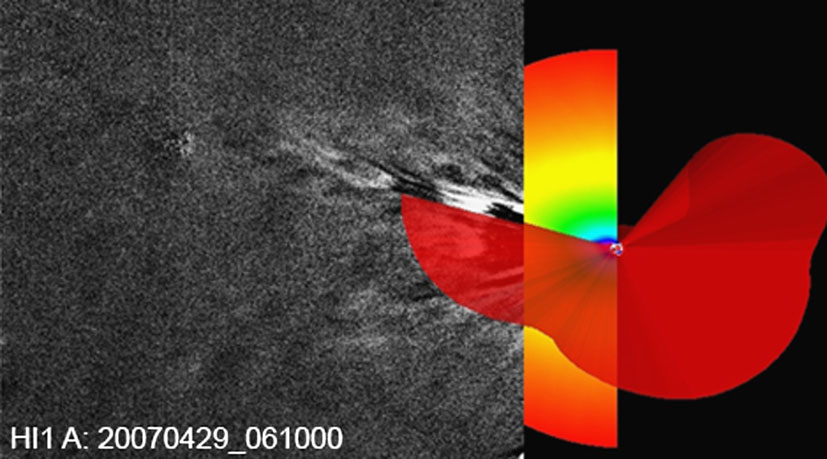‘How does the magnetic field in the solar wind source regions connect to the photosphere and the heliosphere?’
Studies of streamers are the primary means for addressing this question, as they are relatively steady structures from which the slow solar wind is thought to emanate. In-situ observations of the magnetic fields and plasma properties of these structures along the 1D spacecraft trajectory will be combined with remote white light observations by WISPR. Previous insitu observations from outside 0.3 AU have been extrapolated back to the Sun, indicating that the slow wind may originate in these streamers and the closed magnetic fields below them (e.g. Gosling et al. 1981). This conclusion has been supported by remote sensing of the slow wind, for example by interplanetary scintillation measurements from Voyager 2 (Woo and Martin 1997) and via SOHO Ultraviolet Coronal Spectrometer (UVCS; Kohl et al. 1995) Doppler measurements combined with context images from the Large Angle and Spectrometric Coronagraph (LASCO; Brueckner 1995) coronagraphs (Habbal et al. 1997). SPP will for the first time allow us to definitively test this inference. WISPR will image streamers as SPP approaches them, giving a highly accurate measure of when and through which part (i.e., edge, center) the spacecraft flies. The in-situ observations will then measure the plasma properties and the magnetic field in and around that streamer, telling us what the solar wind characteristics are in the streamer, and how they vary across the streamer. WISPR will address fundamental questions about the structure of streamers: Are streamers the folds of a single current sheet encompassing the Sun or are there multiple current sheets which create multiple streamers? Does this structure change from solar minimum to solar maximum? What is the internal structure of streamers? High-resolution WISPR observations on par with those of the LASCO and SECCHI coronagraphs will put the in-situ measurements into context. The current coronagraphs observe streamers globally but are unable to measure their 3D structure at resolutions better than 14◦ (the rate of solar rotation from 1 AU). In contrast, the SPP orbits result in up to 10°ø faster sweeps around the Sun thus enabling streamer 3D tomographic reconstructions from the WISPR images with spatial resolutions of ∼1◦. These reconstructions will allow us to investigate the structures that comprise the heliospheric plasma sheet (HPS) and to study the relation of the HPS to the heliospheric current sheet (HCS), while the SPP in-situ magnetic field measurements will determine the presence or absence of current sheets inside streamers.
| Science Objective | 1. Trace the flow of energy that heats and accelerates the colar corona and solar wind. | 2. Determine the structure and dynamics of plasmaand magnetic fields at the sources of the solar wind. | 3. Explore mechanisms that accelerate and transport energetic particles. | G1. Explore dusty plasma phenomena in the near-Sun environment and their influence on the solar wind and energetic particle formation. | |||||||
|---|---|---|---|---|---|---|---|---|---|---|---|
| Science Question# | 1 | 2 | 3 | 4 | 5 | 6 | 7 | 8 | 9 | ||
| Science Measurement Objective | Velocity and brightness evolution of small scale features in coronal holes and streamers | Location, morphology of the stream interfaces boundaries, and wave turbulance | Map morphology of coronal structure to SPP orbit | Velocity and brightness evolution of small scale features in coronal holes and streamers | Velocity, acceleration and mass density of evolving structures | Location, morphology and speed of shocks near the Sun | Morphology, velocity, acceleration of CMEs and shocks out to SPP Orbit | F-corona brightness, morphology and variability as a function of heliocentric distance | Location, morphology of CMEs and coronal evolution along SPP orbit | ||
| Science Measurements | H-t and mass measurements of solar wind features | H-t and mass measurements of solar wind features | Power spectra of density fluctuations at different heliocentric distances | Images of coronal and heliospheric solar wind structures in visible | H-t and mass measurements of solar wind features | Density power spectra at various heliocentric distances | H-t and mass measurements of solar wind features | High cadence height-time plots and density measurements of CME fronts | High cadence height-time plots and density measurements of CME fronts | Images of F-corona during the orbit | Images and height plots of the corona ahead of SPP passage |
Observation Requirements |
|||||||||||
| Scene Radial Coverage | 14º-90º | 14º-20º | 14º-90º | 14º-20º | 14º-90º | 14º-60º | 14º-90º | 14º-90º | 14º-90º | ||
| Scene Transverse Coverage | 25º-55º | 12º | 25º-55º | 12º | 25º-55º | 25º-55º | 25º-55º | 25º-55º | |||
| Scene Latitude Coverage | -45 to +40º5 | -25º to +15º | -45 to +40º5 | -25º to +15º | -45 to +40º5 | -45 to +40º5 | -45 to +40º5 | -45 to +40º5 | |||
| Image Spatial Resolution (arcmin) | ≤ 6.41,2,3 to ≤ 25.64b | ≤ 6.4 | ≤ 6.41,2,3 to ≤ 25.64b | ≤ 6.4 | ≤ 6.41,2,3 to ≤ 25.64b | ≤ 6.4 | ≤ 6.4 | ≤ 6.41,2,3 to ≤ 25.64b | |||
| Photometric Sensitivity (Signal-to-Noise-Ratio) | ≥ 201,2, ≥ 53,4 | ≥ 20 | ≥ 201,2, ≥ 53,4 | ≥ 20 | ≥ 201,2, ≥ 53,4 | ≥ 201,2, ≥ 53,4 | ≥ 201,2, ≥ 53,4 | ≥ 201,2, ≥ 53,4 | |||
| Cadence (min) | ≤ 401,2,3 ≤ 804 |
≤ 2.51a to ≤16.54a ≤ 4.51b to ≤404b ≤9.01c to ≤804c |
≤ 4 sec | ≤ 401,2,3 ≤ 804 |
≤ 2.51a to ≤16.54a ≤ 4.51b to ≤404b ≤9.01c to ≤804c |
≤ 4 sec | ≤ 181,2 ≤ 403 ≤ 804 |
≤ 5 | ≤ 51a,1b ≤ 101c |
≤ 80 | ≤ 401,2,3 ≤ 804 |
| Baseline Mission Observing Period (days) | 240 | 15 | 240 | 15 | 240 | 240 | 240 | ||||

WISPR will image the extension of streamer structures far into the heliosphere and compare their measured location and densities to in-situ measurements and coronal models. The SECCHI/HI observations have shown that this is possible. In Fig. 3, taken from Vourlidas and Riley (2007), the location of the HCS, based on an MHD simulation, is projected onto a 2-hour SECCHI/HI running difference image showing quiescent solar wind structures. The figure shows that the largest intensity, therefore density, variability corresponds to locations nearest the HCS. These measurements can identify the sources of the solar wind structures when compared with in-situ abundance measurements from SPP, Solar Orbiter, and Earth-orbiting spacecraft. WISPR will have much better sensitivity and spatial resolution than any other heliospheric imager to date (Table 1). Thus, WISPR images will trace the HPS boundaries, their evolution and their relation relative to the HCS in much greater detail than possible with STEREO. When combined with the in-situ observations from the SPP and other missions (e.g. Solar Orbiter), the WISPR observations will provide strong constraints on the origin and evolution of the solar wind plasma in the heliosphere.
